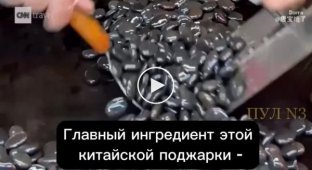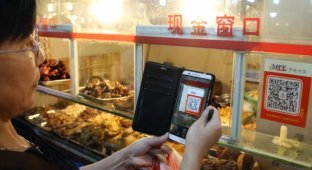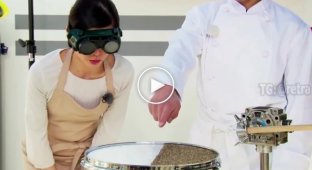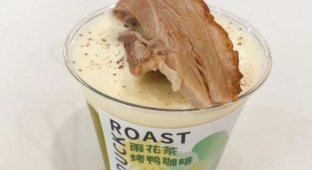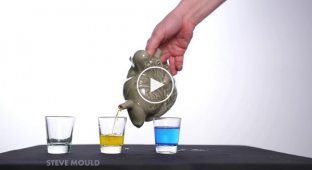Dinner is served! or unusual preferences of Chinese residents (22 photos)
It is a well-known fact that in Asia, they often eat foods that even European and Western gourmets find inedible. And China is a kind of record holder in terms of strange food - both ancient and modern. 
Street food in China.
Already 1000 years ago, the entire territory of the Celestial Empire was very densely populated, and the Chinese had to learn to eat everything that just got into their mouths - literally everything! One of the craziest Chinese delicacies was considered to be fried scorpions, which were eaten with a special sauce. 
Fried scorpions.
Crispy scorpion was considered very healthy. The Chinese believed that such exotic food makes the blood hot on cold winter days. And this, it must be said, is the main principle of Chinese cuisine: there are no inedible products - the main thing is to cook them correctly. 
The Chinese also turned out to be very original in their cooking methods. Firewood was hard to come by for ordinary people, so the Chinese had to find a way to cook without fire at all. 
Cooking in Ancient China.
By the way, one of the most famous Chinese dishes appeared – the “Centennial Egg”. Chicken or duck eggs were not boiled, but coated with a mixture of slaked lime, clay, ash and salt. Then they were placed in baskets and buried in the ground for a couple of months. 
"Centennial Egg".
The "ready" egg tasted salty, but the smell... The persistent smell of rottenness did not leave the room where these eggs were eaten for a very long time! 
Another important principle of cooking according to the Chinese is that food should not only nourish, but also heal. Many still prefer food to pills. It is no wonder that the first Chinese cookbook, which appeared in the 3rd century BC, was called "Healthy Food". 
Ancient Chinese cookbook.
One of these healing Chinese dishes was tongjiedan - eggs boiled in the urine of boys who had not yet reached puberty. During the boiling process, after the urine had boiled, the shells were slightly cracked so that the urine thoroughly soaked the inside of the eggs. 
Tongjiedan.
Eggs were boiled in urine for a whole day, and as it boiled away, new portions of urine were added. 
Tongzedan.
The question inevitably arises: "Why was it necessary to boil eggs... God bless her with urine in general... in the urine of young boys?" I will answer. This very urine was a traditional remedy in Chinese medicine. It was believed that eggs prepared in the above-described way are excellent at reducing fever and increasing blood clotting. However, modern medicine does not confirm this. 
Another healing dish is balut, and again a boiled egg, but this time a duck egg with an already formed embryo. Balut was considered a powerful aphrodisiac in China, containing a large number of healthy substances. 
Balut.
As a healthy "snack", the Chinese often preferred silkworm larvae. After opening the pupae, there were usually many caterpillars left, which were later used to prepare the delicacy. 
Silkworm larvae.
According to the Chinese, the taste of silkworm larvae is very similar to the taste of oysters or crabs, and it must be said that the larvae are popular in China today - canned or... in chocolate. 
Silkworm larvae.
And I won't even mention such Chinese dishes as ram's genitals or rooster's testicles, which were also considered aphrodisiacs. 
Soup with rooster's testicles.
A small lyrical digression. Traditional Chinese cuisine is also called the "5-dimensional cuisine". If European cuisine is mostly a harmony of taste and smell, then in Ancient China food was assessed not by two, but by five parameters: taste, smell, color, texture and...cut. 
There is also another unspoken "dimension" - the type of dish, which for the Chinese was often more important than taste. To the point that particularly picky eaters could refuse to eat unsightly and inharmoniously served food. 
Returning to the topic of Chinese dishes, I cannot help but mention such a traditional dish as "Swallow's Nests" - one of the most expensive in China, just for a second. It is believed that this dish has a miraculous rejuvenating effect, and those who eat it regularly will age much later. According to ancient Chinese treatises, it is especially effective on the skin and hair. Sounds good, don't you agree?! But the nests of ordinary swallows are not suitable for this dish. 
"Swallow's nests".
"Proper" nests are actually not made by swallows at all, but by their relatives, swiftlets, which live on some islands of the South China Sea. They glue their nests together with their saliva, which contains fry, eggs, and other useful things. 
"Swallow's nests".
Nests are removed both before the chicks hatch (they are white) and after. As you can imagine, the second option is more of a hassle, and cooks have to thoroughly clean used nests from feathers, droppings, insects and other delights of bird life. Actually, this is why the cost of this delicacy is so high, and it is generally a great rarity even in China. 
"Swallow's nests".
In ancient times, shark fin soup was included in the list of the 8 main riches of the ocean, and it was very popular with the Chinese nobility, since it was considered a symbol of status and luxury. It was prepared only for special occasions: during a feast, wedding or for official receptions. 
Shark fin soup.
Serving such soup to the table meant showing the highest degree of respect to the guest. The Chinese believed that shark fins also have a rejuvenating effect, improve appetite and have a beneficial effect on the most important systems of the body. 
Shark fin soup.
And finally. The Chinese are still convinced that they invented ice cream. It allegedly appeared in China 200 years before the new era. At that time, only aristocrats could indulge in this delicacy, and it looked completely different from today - it didn't even really have any milk! In ancient China, ice cream was sticky white rice that was thoroughly boiled, mixed with a tiny amount of milk and sweets, and frozen in the snow. 
Making ice cream.












